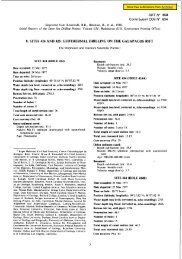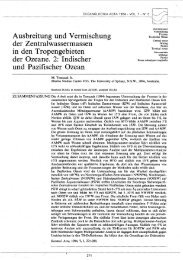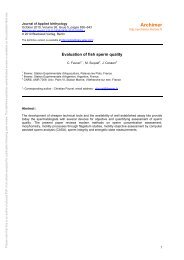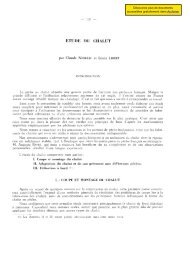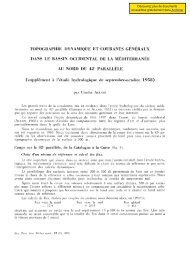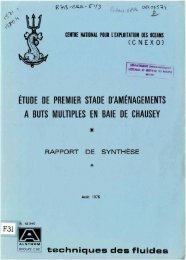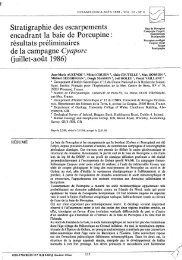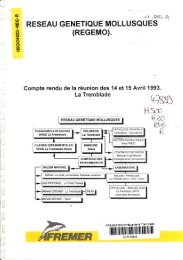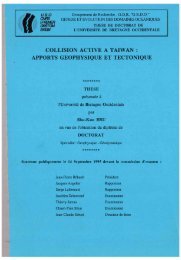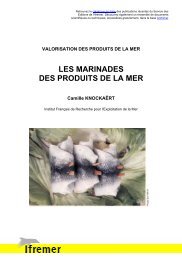Contribution à l'étude de virus de mollusques marins apparentés ...
Contribution à l'étude de virus de mollusques marins apparentés ...
Contribution à l'étude de virus de mollusques marins apparentés ...
Create successful ePaper yourself
Turn your PDF publications into a flip-book with our unique Google optimized e-Paper software.
Third International Symposium on <strong>virus</strong>es of lower vertebrales 529<br />
The binding of the monoclonal antibody<br />
cou Id not be observed using immunohistochemical<br />
methods wh en the ascitic fluids<br />
were diluted 1/50 or 1/10. As no 'positive'<br />
control was performed on the CCV-infected<br />
CCO cells, it was not pcssible ta <strong>de</strong>termine.<br />
whether the antigens were too few in number<br />
to pro duce a visible labelling or if the<br />
fixatives used <strong>de</strong>natured the target antigens.<br />
Using the immunogold method, the polyclonai<br />
antibody diluted 1/10 produced a high<br />
level of background labelling on the CCVinfected<br />
CCO cells and the herpes-like <strong>virus</strong><br />
infected oyster spat and larvae. When the<br />
pclyclonal antibody was diluted 1/100, little<br />
residuallabelling could be observed on the<br />
capsids. These results could be improved<br />
by using better blocking of unspecific binding<br />
sites and also by testing seriai dilutions<br />
of the pclyclonal antibody between 1/10 and<br />
1/100.<br />
However, when immunohistochemical<br />
methods were used, the polyclonal antibody-diluted<br />
1/200 specifically labelled œlls<br />
in infecled oyster spat, localized in the conjunctive<br />
tissues of the mantle, the digestive<br />
gland and the gills. Depending on œlls, the<br />
labelling was localized on the nucleus, the<br />
cytoplasm or bath (figs 2a,b). This was similar<br />
to that of the transmission electron microscope<br />
observations (Nicolas et al, 1992;<br />
Renault et al, 1994a) of <strong>virus</strong> particles localized<br />
in the œil nucleus and/or in the cytoplasm,<br />
<strong>de</strong>pending on the stage of the viral<br />
replication cycle. Moreover, a few œlls were<br />
labelled even in animais that had numerous<br />
lesions in histological examination. This<br />
is in agreement with the transmission electron<br />
microscope observations (Renault et<br />
al, 1994b) which revealed that few cells in<br />
the tissues of infecled spat contained particles.<br />
Immunohistochemistry on infected oys- .<br />
ter larvae was difficult to interprel since it<br />
was not pcssible 10 completely eliminate the<br />
background effect due to unspecific tissue<br />
labelling. However, the labelling observed<br />
on healthy and herpes<strong>virus</strong>-infected larvae<br />
was differen!. The background in healthy larvae<br />
was diffuse and mostly localized on the<br />
digestive gland (fig 2d). The labelling in the<br />
<strong>virus</strong>-infecled oyster larvae was observed<br />
on specifie cells in the mantle tissue (fig 2c).<br />
The results <strong>de</strong>scribed here failed to provi<strong>de</strong><br />
a useful diagnostic tool for oyster herpes<strong>virus</strong><br />
infection of larvae and spat. However,<br />
this work could help to the taxonomie<br />
classification of this new agent and might<br />
further elucidate the relationships between<br />
<strong>virus</strong>es and their hosts (Hayashi et al, 1993).<br />
ACKNOWLEDGMENTS<br />
We wish to thank AP Hedrick for kindly providing<br />
the CCV antibodies. This work was supported<br />
by the Conseil Général <strong>de</strong> la Charente-Maritime.<br />
151<br />
REFERENCES<br />
Hayashl Y, Izawa H, Mikami T, Kodama H (1993) A<br />
monocrOf1al anUbody cross-reactive with three<br />
salmon id herpes<strong>virus</strong>es. J Fish Dis 16, 479-486<br />
Hlne PM, Wesney B, Hay B (1992) Herpes<strong>virus</strong>es associated<br />
with mortalities among hatchery-reared larval<br />
PaciflC oysters Crassostrea gigas. Dis Aquat Org<br />
12,135-142<br />
Le Oeuf! AM, Nicolas JL, AeoauIt T, Cochennec N tl994)<br />
Experimental transmission of herpes-like <strong>virus</strong> 10<br />
axenlc larvae of Pacifie oysler, Crassostrea gigas.<br />
Bull Eur Ass Ash Pathol14, 69-72<br />
Nicolas JL. Comps M, Cochennec N (1992) Herpes-like<br />
<strong>virus</strong> fnfectlng Pacifie oyster larvae, Crassostrea<br />
gigas. Bull Eur Fish Pathol12, 11-13<br />
AenaIAtT. Le Oeuf! AM. Cod1ennec N. Ma"art P (19940)<br />
Herpes<strong>virus</strong>es associated with mortalities among<br />
Pacifie oyster, Crassostrea 9lgas, in France - Com·<br />
parattve study. Rsv Méd Vst 145, 735-742<br />
AenaIAtT, Cochennec N. Le Oeuf! AM, ChoIIet B (1994b)<br />
Herpes-like <strong>virus</strong> infecting Japanese oysler (Crassoslma<br />
gigos) spa!. Bull Eur Fish Patho/14, 64-66



